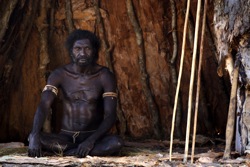NOTE: This article discusses the theatrical version of Ten Canoes containing Yolngu language with English subtitles and English narration by David Gulpilil.
 Ten Canoes is an extraordinarily unique film about the Indigenous Australian Yolngu people, who live in Arnhem Land in the Northern Territory. Under the combined direction of acclaimed Australian filmmaker Rolf de Heer (The Tracker, Bad Boy Bubby) and Peter Djigirr, a local man from the Arafura Swamp region where the film was shot, Ten Canoes combines Yolngu storytelling traditions with a Western approach to narrative cinema. It is not so much the story itself that is of interest in Ten Canoes but the way the story is presented. While conventional filmic techniques are used to indicate different time periods and the division between subjective occurrences and objective occurrences, the way these boundaries are collapsed and the way the story is layered reflects the importance of storytelling to the Yolngu people. As the unseen Storyteller (David Gulpilil) tells us, ‘It’s not a story like your story, but it’s a good story’.
Ten Canoes is an extraordinarily unique film about the Indigenous Australian Yolngu people, who live in Arnhem Land in the Northern Territory. Under the combined direction of acclaimed Australian filmmaker Rolf de Heer (The Tracker, Bad Boy Bubby) and Peter Djigirr, a local man from the Arafura Swamp region where the film was shot, Ten Canoes combines Yolngu storytelling traditions with a Western approach to narrative cinema. It is not so much the story itself that is of interest in Ten Canoes but the way the story is presented. While conventional filmic techniques are used to indicate different time periods and the division between subjective occurrences and objective occurrences, the way these boundaries are collapsed and the way the story is layered reflects the importance of storytelling to the Yolngu people. As the unseen Storyteller (David Gulpilil) tells us, ‘It’s not a story like your story, but it’s a good story’.
It is important to appreciate the immense importance of storytelling to the Yolngu people. Dr Caroline Josephs, who examined sacred oral storytelling traditions for her doctoral thesis, presents Yolngu storytelling as an all-encompassing event that creates a relationship between all things including self, country and kinsman. It combines history with the Dreamtime, past and present, interior experience for the individual and exterior experiences. Josephs writes, ‘It is also primarily an experiential approach to knowing, a felt sense in the body, and can not in my view, be met through analytic conceptual frames of reference.’ In order to ‘explain’ Yolngu storytelling to non-Indigenous people, one must tell a story.[i]
Ten Canoes illustrates the power of storytelling and how it creates a relationship not just between all the characters from the various parts of the film, but with the audience watching the film.
Layered storytelling

Ten Canoes begins with a playful acknowledgement of the type of stories that non-Indigenous Australian audiences are used to seeing. The first line spoken by The Storyteller is the very sombre, ‘Once upon a time in a land far, far away’, which is the famous line that begins the popular Star Wars films. The Storyteller then laughs and says, ‘Nah not like that, I’m only joking’. His story is from a long time ago but unlike Star Wars it does not follow the linear conventions of a classical Hollywood narrative. His story is multi-layered, covers two different time periods, incorporates multiple viewpoints, blends objective events with subjective viewpoints and incorporates perceived events with actual events. The Storyteller describes his story as something, ‘Growing like a young tree that is flowering for the first time’. The tree metaphor is used continuously throughout Ten Canoes and is a useful way of thinking about the story as something that gradually grows and branches out in different directions.
The structure of Ten Canoes is multi-layered and just like the men on the goose egg hunting expedition who peel the bark off trees to make their canoes, the layers of the story are peeled back for the audience so that we can get to the heart of the story. However, like the bark of a tree, each layer has significance and importance to the whole. In the prologue (the external layer) The Storyteller describes the creation of the land and his own birth. His description is a combination of legend and myth and introduces magic and spirits as elements that facilitate the logical chain of events within the context of the story. The Storyteller then begins to describe his ancestors, taking the audience to the next level of storytelling, which concerns the story of young Dayindi (Jamie Gulpilil) on his first goose egg hunting expedition. Over the course of the hunt Dayindi is told a story by his older brother Minygululu (Peter Minygululu), a story set in the mythical times that reflects the situation where Dayindi desires one of Minygululu’s wives. This mythical story then takes us to the next layer of the film, which The Storyteller tells us occurred even further back in time. The story told by Minygululu is about another pair of brothers; Ridjimiraril (Crusoe Kurddal) a proud warrior who like Minygululu has a younger brother (Yeeralparil, also played by Jamie Gulpilil) who desires one of his wives.
The Storyteller
The Storyteller functions as the narrator of Ten Canoes although he is a curious narrator. Like many aspects of the film, his narration does not conform to the classical Hollywood model. He is neither a nondiegetic narrator who is external to the film nor is he a diegetic narrator who exists within the film as one of its characters. Instead, he is something in between. He certainly has the omniscience of a nondiegetic narrator, and is not somebody who the audience ever sees on camera, and yet he describes his own birth as an event that is significant to the film. Sometimes he plays the part of a guide, lowering his voice as if he is actually in the scene and does not want to alert the characters to his presence. The Storyteller’s style of narration alternates between being serious and playful, much like the film itself. Sometimes he conversationally talks to the audience directly and sometimes his narration is detached and observational like a documentary narrator. He is even sometimes contradictory, telling us “all the parts of the story have to be told for proper understanding”, while admitting that bits of the story are missing, as it is so old. The blurred boundaries between his role as detached guide for the audience and some kind of hidden character within the film helps to establish a link between the audience and the film’s characters.
Internal and external experiences

The black and white goose hunting scenes operate as the objective, historical and exterior part of the story while the colour scenes are the subjective, mythical and internal version. Ten Canoes begins as a colour film but when we go back in time to view the Storyteller’s ancestors on their goose egg hunting expedition, the film goes to black-and-white, a technique traditionally used in cinema to indicate the past. The use of black-and-white photography in Ten Canoes has the additional importance of being inspired by the photographs taken by the anthropologist Dr Donald Thomson, who worked in Arnhem Land in the mid-1930s. Thomson had lived with Yolngu people for several months and his photo documentation of their daily lives is an important record of their traditional culture. Many of Thomson’s photographs are treasured by the contemporary descendents of his subjects.
[Thomson’s photographs] have been consumed by the [Yolngu] culture, become part of it. There’s such a concept as “Thomson Time”, fondly remembered. The web of kinship is complex: everyone is related to someone in the photographs, and everyone takes pride in them. They are their continuity, their history. [ii]
To further capture the essence of Thomson’s photography in the goose egg hunting scenes, there is very little camera movement. Shots are either static or the camera movement is extremely slow and gentle. The camera never gets too close to the subjects either and most shots of the goose egg hunting expedition are from a distance, never getting much closer than a medium shot. This slightly detached and cinematically traditional style of cinematography certainly heightens the documentary feel of these sections and provides a wonderful contrast to the stylistic overload of the next layer of storytelling – Ridjimiraril and Yeeralparil’s story.

As Minygululu begins to tell Dayindi about Ridjimiraril and Yeeralparil, there is a gradual tracking shot from left to right that gradually transforms from black-and-white into colour to indicate that we are now being taken right back in time to the mythical times. Using colour to indicate an age that is even older than the black-and-white scenes of the goose egg hunt, gives these scenes a magical quality. The camera is now always moving, either ‘floating’ through the bush to follow the characters or moving around a character if they are standing still. This sometimes graceful and sometimes disorientating constant movement gives these scenes a sense of serenity and otherworldliness. Characters frequently speak directly into the camera giving the audience the impression that they are immersed in the world of the film and being addressed directly by the characters. Magic Realism is also used in many sequences in this part of the story. For example, during the payback ceremony Ridjimiraril and Yeeralparil become transparent because, ‘They danced so hard, they were nearly invisible’. Ridjimiraril’s death dance sequence is also a heavily stylised sequence that emphasises the link between the tangible world and the spirit world that Ridjimiraril is about to enter.
Many shots from the mythical parts of Ten Canoes are from the point-of-view of various characters. What they imagine has happened, or will happen, is depicted on screen with the same amount of narrative importance as the scenes depicting actual events. These are also some of the most vibrant sequences in the film. The sequence when the men discuss how they will rescue Ridjimiraril’s wife Nowalingu (Frances Djulibing) is an example of subjective storytelling. As each man discusses a possible plan they are shown in close-up against a blank background as if they have been removed from the world and are now in an imaginary universe. Their various ideas come to life on screen in a series of bold camera angles such as birds-eye-views and dramatic camera movement where the camera rushes into the action as if it were one of the men rushing in.

The use of Magical Realism, imagined sequences and cinematic techniques that convey subjectivity serve to unearth a core message in the film regarding the dangers of false perception. It is a universal message and in Ten Canoes it manifests as the tragic series of events that result from Ridjimiraril’s anger, paranoia and jealousy over the disappearance of Nowalingu. The Stranger (Michael Dawu) is suspected as the person responsible for kidnapping Nowalingu and he is depicted as somebody different from Ridjimiraril’s people. He is first shot suspiciously from a distance so that even the audience cannot get a proper look at him. He suspiciously has his penis covered, unlike Ridjimiraril’s people, and he has a nervous tick. When Ridjimiraril and some of the other men discuss the possibility of The Stranger doing spells on them, the film visually depicts these imagined crimes as if they were so. The fear and paranoia of the men becomes real in this subjective part of the film. Although Ridjimiraril later imagines an ideal scenario where The Stranger agrees to help him find Nowalingu, the self-perpetuating social fears are too strong, resulting in Ridjimiraril killing an innocent man.
When writing about the Yolngu way of storytelling Caroline Josephs comments, ‘Outside or exterior experiences will always be parallelling interior internal experiences in symbolic ways, in feeling states and in states of mind.’[iii] In Ten Canoes the interior/subjective story of Ridjimiraril and Yeeralparil is paralleled to the exterior/objective story of the men of the goose-hunting trip. One is a story being told within the other, the Storyteller gives equal importance to both stories, the same actor plays Dayindi and Yeeralparil and there are strong visual links. The most striking visual link is the shot of Ridjimiraril, Yeeralparil and the other men on their canoes in the swamp, waiting for the payback ceremony, which matches the shot of the men on the goose-hunting trip.
Beyond the story
 The final key to understanding the power of the storytelling within Ten Canoes is to be aware that the stories contained within the film do not just resonate through the different layers of the film, but resonate beyond the film itself. Within the film audiences will recognise aspects of daily life that reflects their own. There is generational conflict, sexual tensions, everyday routine and jokes about sex and bodily functions. The storytelling is different, the culture is different but it is the elements of sameness that make Ten Canoes such an engaging film.
The final key to understanding the power of the storytelling within Ten Canoes is to be aware that the stories contained within the film do not just resonate through the different layers of the film, but resonate beyond the film itself. Within the film audiences will recognise aspects of daily life that reflects their own. There is generational conflict, sexual tensions, everyday routine and jokes about sex and bodily functions. The storytelling is different, the culture is different but it is the elements of sameness that make Ten Canoes such an engaging film.
The lessons that Dayindi learns from his brother’s story are ones that apply universally. Firstly Dayindi learns that it is dangerous to allow your prejudices and perception of events to become compromised, like Ridjimiraril did. The other two lessons are very simple lessons. Firstly, there is the Judo Christian, ‘thou shalt not covet thy neighbour’s wife’ lesson about not desiring the wife of another man. The other lesson Dayindi learns is the well-known lesson, ‘Be careful what you wish for’. Dayindi’s predicament at the end of the film where he is torn between the demands of Ridjimiraril’s wives illustrates this lesson quite plainly. These lessons themselves are not so much of interest as the fact that they are so universal. What is more significant is that the layered and interrelated storytelling technique of the Yolngu people contains values that resonate with white audiences, or balanda, as the Yolngu would say.
Ten Canoes does not have a closed resolution, which is something The Storyteller jokes about when he borrows the famous fairy tale line, ‘And they all lived happily ever after’ before once more laughing and then explaining that he actually does not know what happened afterwards. The story is left open, as it has no fixed resolution. It therefore has the power to live beyond the time and place that it was set because the importance and resonance of the story is not confined by the events it describes. This gives the story a sense of timelessness and makes it universally relevant beyond the confines of the film.
[i] Dr Caroline Josephs, ‘Silence as a way of knowing in Yolngu Indigenous Australian storytelling’ in Elizabeth Burns Coleman and Maria Suzette Fernandes-Dias (eds.), Negotiating the Sacred II: Blasphemy and Sacrilege in the Arts, ANU E Press, Canberra, 2008, pp173-189. Also available at http://epress.anu.edu.au/nts02_citation.html
[ii] Ten Canoes Press Kit, http://www.tencanoes.com.au/tencanoes/pdf/Background.pdf, page 6
[iii] Josephs, op. cit., p174
Originally published in issue 54 (Winter 2009) of Screen Education.


Great review, Thomas. The Ten Canoes website is a must to visit – so dense.
The thing that really struck me about the film was how de Heer was able to recreate Thomson’s photos in such detail within the natural landscape – so long ago, but so little had changed. And the story itself is hilarious (for the most part).
Thanks ND!
Yes, the Ten Canoes website is highly recommend: http://www.tencanoes.com.au/
The Twelve Canoes website, which sort of functions as an extension of Ten Canoes is also pretty remarkable: http://www.12canoes.com.au/
Cheers
Thomas